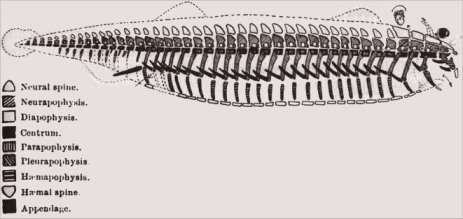
 Richard Owen was
the son of a West India merchant. He studied briefly at Edinburgh (1824), then
at a private London anatomy school. Through hard work and serious networking,
Owen pushed his way to the heights of Victorian science. In 1827 he was appointed
Assistant Curator of the Royal College of Surgeons' Hunterian Collections and
then Hunterian professor (1836), and conservator (1842). He was elected to a
fellowship of the Royal Society in 1834 for his work on monotremes and marsupials.
Following his mentor Joseph Henry Green, Owen promoted an idealist biology based
on German Naturphilosophie.
Richard Owen was
the son of a West India merchant. He studied briefly at Edinburgh (1824), then
at a private London anatomy school. Through hard work and serious networking,
Owen pushed his way to the heights of Victorian science. In 1827 he was appointed
Assistant Curator of the Royal College of Surgeons' Hunterian Collections and
then Hunterian professor (1836), and conservator (1842). He was elected to a
fellowship of the Royal Society in 1834 for his work on monotremes and marsupials.
Following his mentor Joseph Henry Green, Owen promoted an idealist biology based
on German Naturphilosophie.
By the mid-1840s Owen was the leader of British comparative anatomy and an important exponent of a natural theology or attribution of design in nature. In 1842, he named the taxon Dinosauria. The support Owen lent to orthodox men of science and supporters of the status quo and sometimes a fawning elitism made him a favourite of elite conservative patrons. The royal family presented him with a cottage in Richmond Park and Robert Peel put him on the Civil List.
Owen later became Fullerian professor at the Royal Institution in 1858, and
president of the British Association for the Advancement
of Science (1858). AS head of the natural history departments of the British
Museum, Owen oversaw the transfer of these collections to the new South Kensington
Natural History Museum in 1881. He was knighted in 1884.
In his notorious review of the Origin of Species in 1860, Owen tried to undercut Darwin's priority by attributing evolution to a mysterious "continuous operation of the ordained becoming of living things". As Owen had long been an apparent opponent of evolution, this about-face infuriated Darwin's supporters, especially Huxley, who saw Owen trying to steal Darwin's credit. Huxley had long competed for authority and status and their rivalry is one of the most notorious in Victorian science.
Through his hard work and prolific publications Owen became known as the British Cuvier. Owen established a reputation as a great anatomist with his Memoir on the Pearly Nautilus (1832). Owen's views on the possible transmutation of species evolved during his lifetime. At first he had espoused a Cuverian functionalism. Each species evinced a unique design to suit if for its role in the economy of nature. This view was amenable to British natural theologies and although smacking a bit continental, was considered safe science by Owen's elite patrons. Owen's views changed by the mid-1840s reflecting the work he had done comparing the anatomy of vertebrates. Owen believed he recognized Platonic "archetypes" or ideal forms reflected in particular species. Today we would say that he offered this as an explanation for vertebrate homologies.
Related Material
- Sir Thomas Brock's statue of Owen in the Natural History Museum, London
- W. Holman Hunt's Sir Richard Owen, KCB, DCL
- The Dinosaur Court, Crystal Palace Park, which Owen and others created
Further reading
Brooke, John Hedley, "Richard Owen, William Whewell, and the Vestiges." British Journal for the History of Science 10, 1977, pp. 132-45.
Camardi, Giovanni. 'Richard Owen, Morphology and Evolution', Journal of History of Biology, 34(3), 2001 pp. 481-515.
Gardiner, Brian G. 'Edward Forbes, Richard Owen, and the Red Lions.' Archives of Natural History,1993, 201 349-72.
MacLeod, Roy M., 'Evolution and Richard Owen', Isis, 56, 2965, pp. 259-80.
Owen, Richard, The Life of Richard Owen by His Grandson. 2 vols. London: 1894.
Richards, Evelleen, 'A Question of Property Rights: Richard Owen's Evolutionism Reassessed', British Journal for the History of Science, 20, 1987, pp. 129 -71.
Rupke, Nicolaas A. "Richard Owen's Vertebrate Archetype." Isis 84, 1993, pp. 231-51.
Rupke, Nicolaas A., Richard Owen: Victorian Naturalist. New Haven: 1994.
Online resources
[Richard Owen,] 'Darwin on the Origin of Species', Edinburgh Review, 3, 1860, pp. 487-532.
Sir Richard Owen: The archetypal villain
Owen: Berkeley history of evolution
Owen:
Lancaster's Unsung Scientific Heroes
Last modified 28 September 2002; links added 14 August 2011